Learn the differences between leads, prospects, and opportunities. Understand how to turn leads into prospects and opportunities.
A business proposal letter is a one-page document that serves as the persuasive summary or cover letter for a comprehensive business proposal. Its goal is to briefly highlight the most important aspects of your full proposal. While not required, it’s good to use if you want to convey a higher level of professionalism, to build trust or credibility, to provide added context, or to deliver a short pitch. You can then send the letter in an email or as a physical copy.
Make sure your proposal letter introduces a professional and memorable business proposal for the best results. Hire a design expert on Fiverr to custom-design a business proposal for as little as five dollars. Fiverr is a gig-based marketplace with experts offering editable proposal designs you can customize for each prospect and send as a PDF. Check out the top gigs below:
A good proposal letter is formatted as a single page containing 3-4 paragraphs and fewer than 400 words, with five key elements. To write a formal business proposal letter that encourages your prospect to continue reading to your full proposal follow these steps:
Once you draft your business proposal letter, send it to your prospect along with your full proposal. You can mail a hardcopy with the letter on top and the proposal underneath, or more commonly, you can email it. If your contact is the decision maker, paste the letter into the body of an email and attach the proposal. If your contact might forward your email to others, also make the letter the first page of the proposal.
Remember that just like your full business proposal, your proposal letter should be customized for your unique prospect. It should also accurately summarize and tease your proposal, so make sure the information between the two documents are aligned and build off each other. For information on writing a full-blown proposal and how it ties into your proposal letter, read our article on how to create a business proposal.
In some cases, people use the terms “business proposal letter” and “business proposal” interchangeably. This refers specifically to a one-page business proposal. Businesses selling smaller projects or drafting a proposal to companies they have a good relationship with often use a one-page proposal containing both the letter and details.
We’ve created a free business proposal letter template that incorporates the crucial elements listed above, as well as examples of what to write for each. Personalize it to your specific sales situation by simply replacing the words in parentheses (aka, the fields) with your own writing. We’ll show you how to do this throughout the article, incorporating screenshots of each section.
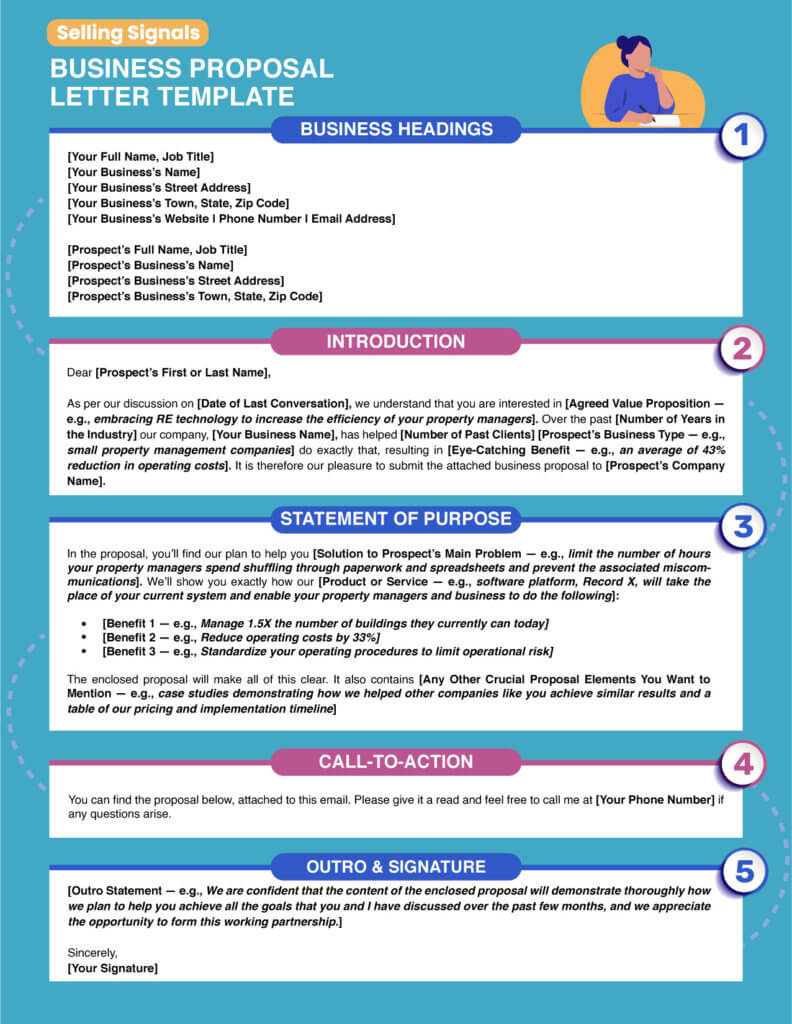
Check out each of the major components of an effective business proposal letter below, starting with business headings, continuing on with an introduction, statement of purpose, and call-to-action, and wrapping up with a strong outro.
Business headings provide a formal touch for your business proposal letter and include contact information for your business as well as the recipients, such as the business name, address, and points of contact. For more informal business proposal letters or proposal letters you send via email, you can consider omitting this portion of your letter.
Your introduction is an opportunity to re-introduce yourself and remind your lead, prospect, or recipient why you're sending the associated proposal. This also gives you a chance to provide any relevant social proof to prime them before reading your full proposal, as well as tease the overall purpose.
This acts as a summary of the most important contents of your business proposal: their problem, your solution, and the benefits the prospect will receive. This gives you a chance to highlight the most important points of your proposal and accurately communicate your elevator pitch or USP for the scanning reader.
Conclude with a sentence that tells the reader what to do next. Usually, this next step will be to read your attached proposal, but it can also be to request a call or meeting to review the proposal together or to ask and answer any questions that may have arisen after reviewing. If this is the case, use concrete language with a specific ask, such as "use my Calendly link to book a time to connect this week."
Now that you understand the purpose of each section of the letter, follow our step-by-step instructions to write your own business proposal letter.
To write a letter that effectively introduces and summarizes the proposal, draft each of the five elements in order. Below, we'll show examples of each element from our free template. Be brief and to the point, including only the most crucial information and using clear, simple language to help the reader remain engaged. Personalize the letter so the prospect feels that you’ve listened to and truly understood their specific needs — this can inspire them to work with you over your competitors.
Add business headings to the top left-hand side of your letter, listing standard information about both your business and your prospect’s. List full names, job titles, companies, addresses, and contact information, as shown below. This helps the reader know this letter is for them and which business it’s from, which can be helpful if they’re assessing multiple vendors.
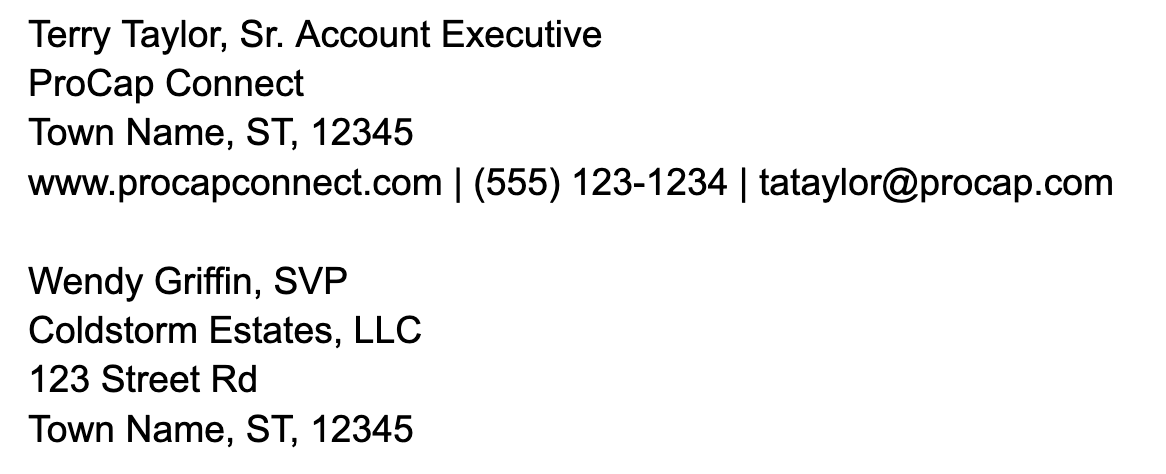
Some business proposals also include the date at the top, above the business headings. Some make their business information a header across the top of the page and paste their logo onto it. Do what you think looks best, and combine rows to save space if needed. This element is essentially a formality. As long as it looks organized and professional, it won’t impact the success rate of your proposal. If it looks sloppy, it might hurt it.
The introduction element is the beginning of the body of your proposal letter, starting with a greeting like “Dear {Prospect Name}” and ending with a segue into the statement of purpose. Personalize the introduction to the prospect’s unique situation to make them feel understood; do this by beginning with background information that you’ve uncovered through conversations with them, like the agreed-upon value proposition. Keep it under 100 words, if possible.
Let’s go over the bolded fields in our template using the screenshot below. Include individual and business names, plus the following:
Here's how these prompts fit into our free template:
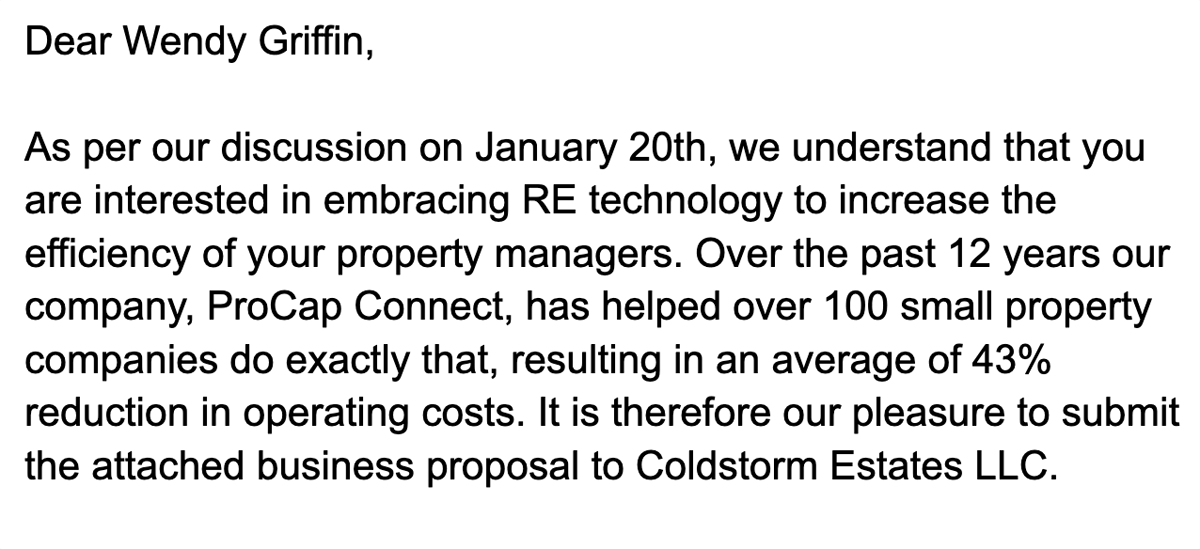
Now it’s time to write the statement of purpose element of your business proposal letter. This is arguably the most critical portion of the letter, so it receives the greatest length: about 175 words. It summarizes what the prospect will learn in the attached proposal and the proposal’s purpose: to show them how you’ll help them solve a problem or achieve a goal. This element should also highlight some key benefits or your unique selling proposition (USP) to increase their curiosity.
Below are the statement of purpose fields and how to complete them:
We've included these elements in our free template using paragraphs and bullets:
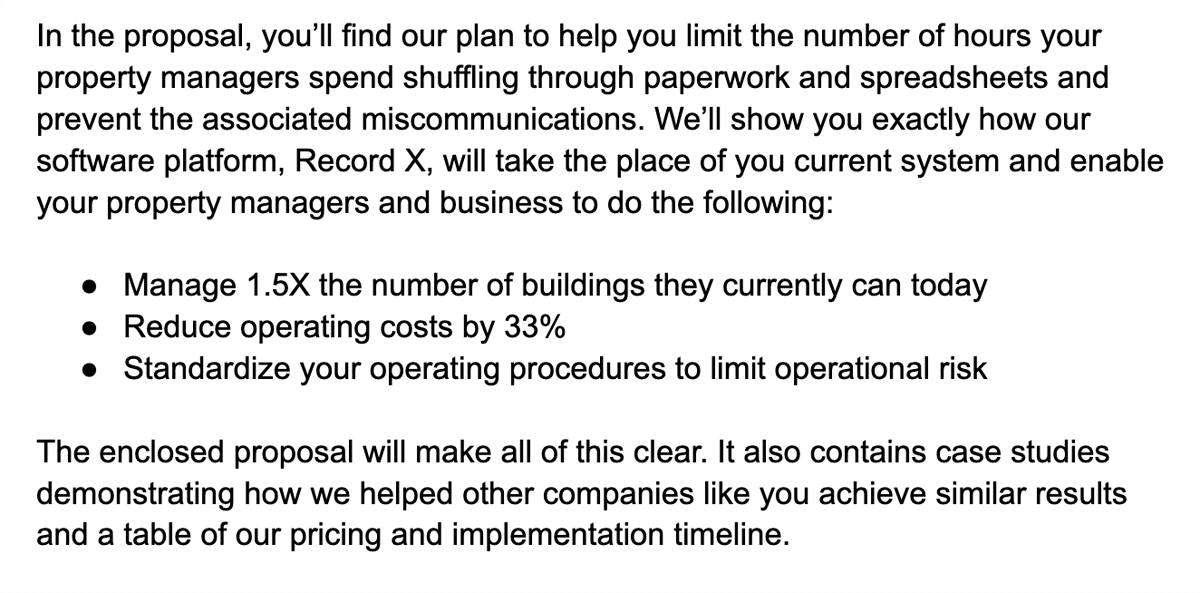
You may be wondering if cost should get a spot in the letter. It’s generally best practice to exclude cost. There’s a reason the pricing comes at the end of the full proposal — by then, the prospect will fully understand the value you offer, which makes the cost more digestible. The only time you’d include your cost is if it were a main selling point (perhaps your cost is far below the competition’s), in which case you’d include it in the paragraph after the bulleted list.
Your call-to-action (CTA) is where you tell the prospect what you want them to do next. This is typically to open and read the attached business proposal. You can also ask them to call or email you when they’ve finished reading it or as questions arise, or to set up a meeting in advance so they’ll finish reading it by the time you connect again. Sometimes, it'll be appropriate to include a contract and ask the prospect to sign it if they have no concerns.
Here are four potential CTAs to use:
As you can see, each CTA tells the recipient to read the proposal and lays out next steps for what the prospect should do after they’ve finished reading. This tactic is effective because it solidifies next steps. We recommend going with an option that politely nudges the prospect to commit to a future meeting during which you can discuss the proposal and move the sale to a close. This accelerates the sales cycle velocity.
If you prefer a gentler approach, use the CTA in our template:

Your outro should be 1-2 sentences expressing confidence in your proposal while also thanking the prospect for considering you as a potential partner, supplier, or vendor. This ends the letter on a friendly note and also gives one last reason why reading the proposal will be beneficial. Below the final line of the body, sign off using “sincerely” and your full name or email signature.
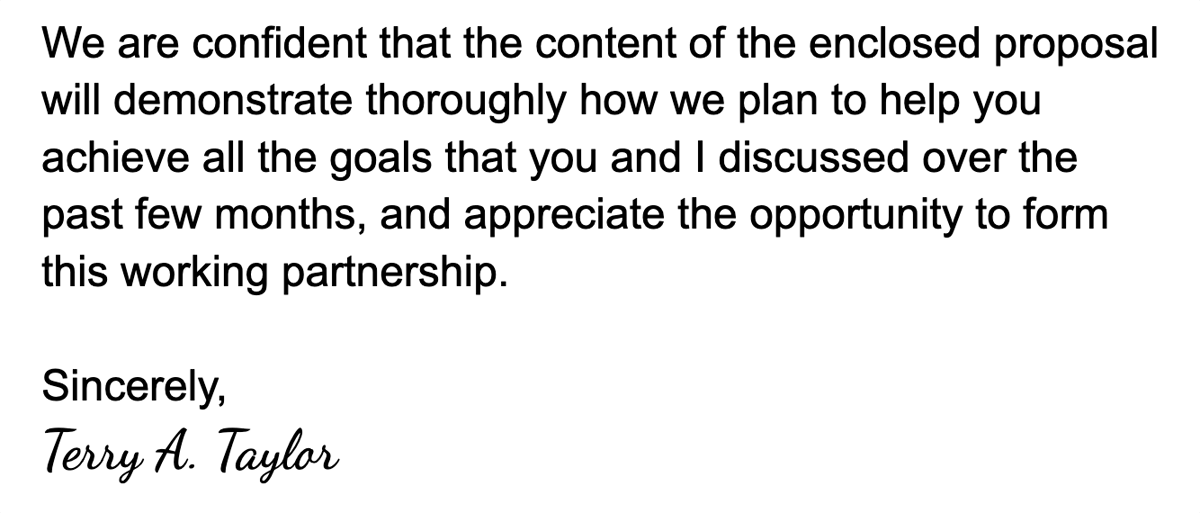
A handwritten signature adds a personal touch. If you don’t already have an esignature, you can easily include one by signing a piece of paper, taking a photo, then pasting that image into the Word, Google Docs, or PDF document of your letter.
In addition to the template we’ve given you above, it can also be helpful to review and learn from real-world examples of proposal letters. Check out the specific examples below for guidance in creating your own.
Take a look at these four business proposal letter examples from around the web by scrolling left and right below. You can learn new techniques, formats, and phrasing from each of them. The more you study other businesses’ proposal letters, the better you’ll be at crafting your own.
Oftentimes, it's best to start with a template and then modify it to best fit your business and to incorporate ideas from examples you see online. Then, you can simply tweak your new template for each unique prospect.
A business proposal letter isn’t required when sending a full proposal. However, it has many benefits, and you should strongly consider it. Salespeople write business proposal letters for these reasons:
Overall, use business proposal letters on a case by case basis, rather than trying a one size fits all solution. Your prospects will appreciate the time and effort that personalized business proposal letter will reflect.
An official business proposal is a multipage document or presentation that outlines all terms of a deal between you and a prospect. This includes a cover page, table of contents, executive and problem summary, proposed solution, qualifications, timeline, pricing, and terms and conditions. Proposals can act as a legitimate contract if you wish to include a signature field. Proposal letters act as an introduction to this entire presentation by explaining its purpose to the prospect.
One-page proposals are a single-page document that clearly defines the solution, benefits, and terms of a deal between you and your prospect. They’re an alternative to a full blown proposal and typically work best for smaller deals or more intimate relationships. Business proposal letters aren’t meant to stand alone as one-pagers can. Instead, proposal letters work to introduce the purpose and goal of an official business proposal that you then present to your prospects.
Your business proposal letter is an effective lead nurturing tool and is your business proposal’s first impression. It sets the tone for what’s to come and gets the prospect excited about reading your plan to help them achieve their goals. To do this effectively, it must focus on the prospect. Accolades and rewards aside, your business must take the backseat here. Use this single page to show the prospect you know exactly how to help and get them to read your full business proposal.